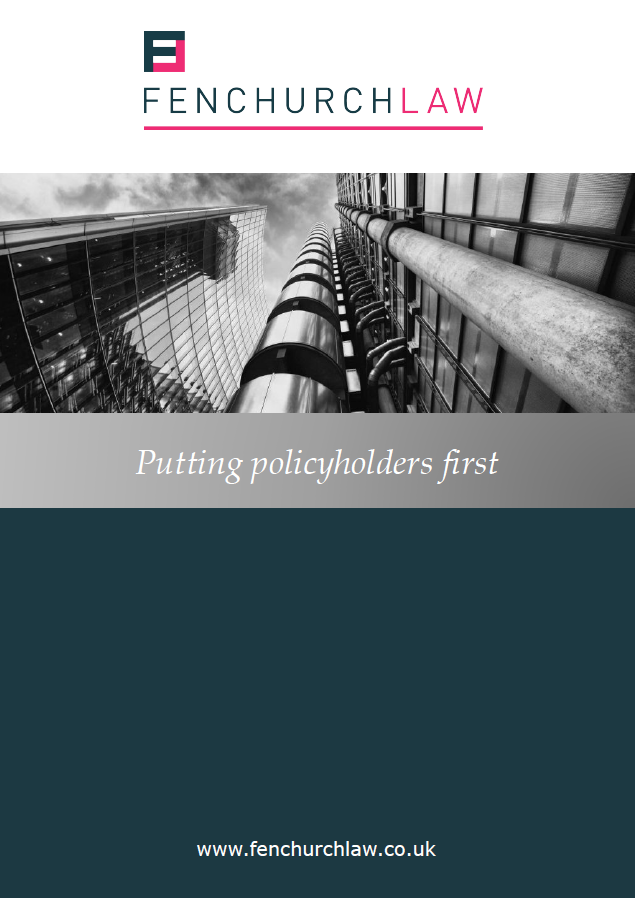
The Good, the Bad & the Ugly: 100 cases every policyholder needs to know. #7 (The Good). Woodford and Hillman -v- AIG
Welcome to the latest in the series of blogs from Fenchurch Law: 100 cases every policyholder needs to know. An opinionated and practical guide to the most important insurance decisions relating to the London / English insurance markets, all looked at from a pro-policyholder perspective.
Some cases are correctly decided and positive for policyholders. We celebrate those cases as The Good.
Some cases are, in our view, bad for policyholders, wrongly decided, and in need of being overturned. We highlight those decisions as The Bad.
Other cases are bad for policyholders but seem (even to our policyholder-tinted eyes) to be correctly decided. Those cases can trip up even the most honest policyholder with the most genuine claim. We put the hazard lights on those cases as The Ugly.
At Fenchurch Law we love the insurance market. But we love policyholders just a little bit more.
#7 (The Good)
Woodford and Hillman -v- AIG [2018] EWHC 358
There are few cases dealing with coverage issues under D&O policies. This isn’t necessarily because D&O policies are rarely the subject of dispute. It is more likely a reflection of the fact that if directors have to fund hefty legal costs in defending complex civil, criminal or regulatory actions because insurers are being difficult about costs or refusing outright to pay them, their personal finances are depleted to the point where suing the insurer is out of the question (and the Financial Ombudsman’s service is no help because that avenue of remedy is closed off to company directors). The consequence is that insurers’ obligations to fund defence costs are rarely scrutinised in court.
Occasionally, though, directors will take D&O insurers on, notwithstanding the power imbalance and the personal financial risk. Two such directors were Mr Woodford and Mr Hillman. They had been directors of the Olympus Corporation. They left in 2011 when Mr Woodford blew the whistle on a financial scandal.
In 2015 Olympus launched proceedings against them in the High Court in London for £50m, claiming that their involvement in an Executive Pension Scheme while at Olympus breached their duties as directors.
Olympus had D&O cover which covered past directors. Woodford and Hillman notified the claim to the D&O insurers, AIG, seeking an indemnity.
AIG’s resistance to Defence Costs
AIG refused to fund Woodford and Hillman’s defence costs (£4m and counting) claiming they were not reasonable. The policy was governed by German law but disputes fell to be determined in England.
The D&O policy made AIG liable for legal defence costs “provided these are reasonable with regard to the complexity and significance of the case”.
AIG argued that their liability for costs should be determined by a costs assessment. This is an assessment by a costs judge, normally undertaken when litigation ends, to determine how much of the winning party’s costs the loser should pay. The costs judge very critically examines the costs being claimed. The party whose costs are being assessed should expect to take a hair-cut on their recovery. A discount of 30% is not unusual and full recovery is very unlikely. On any view, therefore, a referral to costs assessment, as insisted on by AIG, would have involved Woodford and Hillman being left significantly out of pocket.
The Judge held that a costs assessment was not the right way to determine AIG’s liability for defence costs. Such an assessment was appropriate at the end of litigation as part of the court’s general discretion in relation to costs. An indemnity for defence costs under a D&O policy was “very different”. The Judge said that an insurance policy is intended to indemnify the directors for defence costs. Indemnity was a contractual right which meant that the court had no inherent discretion in relation to such costs. This meant that the (discretionary) costs assessment process had no application.
Instead, the court should assess the right to defence costs in the same way it would assess any issue of quantum. The criteria set out in the policy was that the costs were payable if “reasonable with regard to the complexity and significance of the case”.
The basis for the assessment of the “complexity and significance” of the case faced by the insureds was that it:
- would involve a three-week High Court trial;
- dealt with complex issues in a specialist area of law (pensions);
- was for a significant sum (£50m);
- had reputational significance for insureds because of the seriousness of the allegations.
AIG’s particular objection was to the charge-out rates of the insureds’ city lawyers: £508 for partners and senior lawyers; £389 for mid–level lawyers and £275 for junior lawyers. The Judge held that the complexity and significance of the matter meant it was reasonable to use a City firm at the rates charged. The Judge rejected AIG’s suggestion that the Guideline Hourly rates published by the Court Service for use in a costs assessment (rates significantly lower than City lawyers charge) had no application.
AIG’s determined resistance to paying the fees did not stop there. They complained of duplicated work, excessive billing, failure to delegate appropriately, churning of costs (an allegation that AIG dropped) and engagement of two QC’s. The Judge found that the QC appointments were reasonable in the context, the fees were reasonable and AIG’s other complaints were unsubstantiated.
Woodford and Hillman were awarded all their defence costs: they had been incurred reasonably in view of the complexity and significance of the case against them.
Implications
It is standard for a D&O insurer’s liability for costs to be qualified on grounds of reasonableness. It is now clear that an insurer’s attempts to call in aid the cost assessment process with a view to chipping away ultra-critically at the defence costs claimed by insureds should not work and there are better prospects of the directors’ outlay on defence costs being matched by insurance cover. Insureds now have a case to use when firing back at insurers’ attempts to lowball them, giving them some hope of prising the insurer’s purse open that little bit wider.
Enterprise Act Angle
Woodford and Hillman had to fund their defence costs from their pension funds because the D&O insurer was not responding. They incurred significant tax consequences as a result. Had the policy been governed by English law (and had it been taken out after May 2017) they may also have had a claim against AIG for damages for breach of the obligation to pay claims within a reasonable time (an obligation introduced by the Enterprise Act 2016) equal to the tax charge they suffered as a result of accessing their pension funds. Application of the Enterprise Act might have had an impact on the insurer’s approach to the case.
John Curran is a partner at Fenchurch Law
Other news
Commercial Court grounds War Risks insurers in landmark Russian aircraft judgment
30 June 2025
Please find a link to the judgment here - Russian Aircraft Lessor Policy Claims [2025] EWHC 1430 (Comm) Introduction On…
You may also be interested in:
Archives
Categories
- Press Release
- Uncategorized
- The Good, the Bad and the Ugly
- Fenchurch Law Webinars
- Stonegate
- Newsletter
- Events
- Webinars
- Comparing German and English Insurance Law – A Series
- Construction Risks
- Operations
- Business Development
- Construction & Property Risks
- News
- International Risks
- Legislation
- Financial & Professional Risks
- Case Law
- Professional Risks



